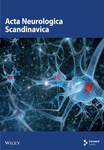Analysis of effector CD4 (OX-40+) and CD8 (CD45RA+ CD27-) T lymphocytes in active multiple sclerosis
Abstract
Objectives - Recently, effector T-cell subpopulations have been identified that can be distinguished by expression of members of the TNF-R family: CD4+OX-40+ cells are CD4 helper-effector cells CD8+CD45RA+CD27- cells are CD8-killer-effector cells. We investigated whether these lymphocyte subsets were increased in the active phase of multiple sclerosis (MS). Material and methods- Multiple colour immunofluorescence staining was performed on peripheral blood lymphocytes of 28 patients with active MS and of 29 healthy controls, followed by FACS analysis. Results - Frequencies of CD8-killer-effector cells showed a wide interindividual range in both groups and percentages of CD4 helper-effector cells were low. No significant difference between the groups was observed for these subsets, but CD8+CD45RA-CD27- were increased in MS. In healthy individuals, CD4 helper-effector cells correlated with the total percentages of memory cells. Moreover, CD4+ and CD8+ memory cells were strongly correlated. Conclusions- The here described recently identified effector CD4 and CD8 lymphocyte subpopulations were not increased in clinically active MS. It is however still possible that in MS, myelin-specific encephalitogenic cells reside within these subsets.




